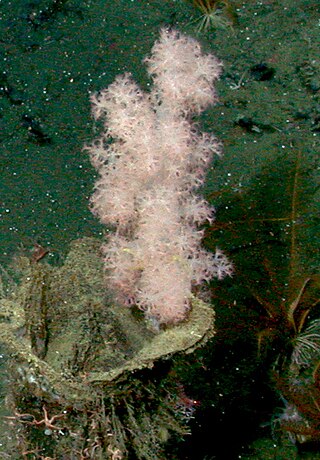
Hydrozoa is a taxonomic class of individually very small, predatory animals, some solitary and some colonial, most of which inhabit saline water. The colonies of the colonial species can be large, and in some cases the specialized individual animals cannot survive outside the colony. A few genera within this class live in freshwater habitats. Hydrozoans are related to jellyfish and corals and belong to the phylum Cnidaria.

Zyzzyzus is a genus of marine tubulariid hydrozoans, which grow embedded in sponges.

Hydractinia echinata is a colonial marine hydroid which is often found growing on dead, hermit-crabbed shells of marine gastropod species. This hydroid species is also commonly known as snail fur, a name which refers to the furry appearance that the hydroids give to a shell.

Hydroidolina is a subclass of Hydrozoa and makes up 90% of the class. Controversy surrounds who the sister groups of Hydroidolina are, but research has shown that three orders remain consistent as direct relatives: Siphonophorae, Anthoathecata, and Leptothecata.

Leptothecata, or thecate hydroids, are an order of hydrozoans in the phylum Cnidaria. Their closest living relatives are the athecate hydroids, which are similar enough to have always been considered closely related, and the very apomorphic Siphonophorae, which were placed outside the "Hydroida". Given that there are no firm rules for synonymy for high-ranked taxa, alternative names like Leptomedusa, Thecaphora or Thecata, with or without the ending emended to "-ae", are also often used for Leptothecata.

A gonophore is a reproductive organ in members of the Hydrozoa which produces gametes. It is a sporosac, a medusa or any intermediate stage. The name is derived from the Greek words γόνος and -φόρος.
Bougainvilliidae is a family of marine hydroids in the class Hydrozoa. Members of the family are found worldwide. There are sixteen accepted genera and about ninety-three species.

Bougainvillia muscus is a marine invertebrate, a species of hydroid in the suborder Anthomedusae.

Tubularia indivisa is a species of large hydroid discovered in 1758.

Eudendrium ramosum, sometimes known as the tree hydroid, is a marine species of cnidaria, a hydroid (Hydrozoa) in the family Eudendriidae of the order Anthoathecata.

Obelia longissima is a colonial species of hydrozoan in the order Leptomedusae. Its hydroid form grows as feathery stems resembling seaweed from a basal stolon. It is found in many temperate and cold seas world-wide but is absent from the tropics.

Hydroids are a life stage for most animals of the class Hydrozoa, small predators related to jellyfish.

The tubular hydroid is a species of hydroid cnidarian, and is found in temperate coastal waters. It is a member of the family Tubulariidae.

Cassiopea xamachana, commonly known as the upside-down jellyfish, is a species of jellyfish in the family Cassiopeidae. It is found in warm parts of the western Atlantic Ocean, the Caribbean Sea, and the Gulf of Mexico. It was first described by the American marine biologist Henry Bryant Bigelow in 1892.

Pennaria disticha, also known as the Christmas tree hydroid, is a species of athecate hydroid in the family Pennariidae. Colonies are common in the Mediterranean Sea growing on rocks close to the surface. This species has been used in research into prey capture.

Halecium halecinum, commonly known as the herring-bone hydroid, is a species of hydrozoan in the family Haleciidae. It is native to the eastern Atlantic Ocean, the western Atlantic Ocean and the eastern Pacific Ocean.

Obelia dichotoma is a broadly distributed, mainly marine but sometimes freshwater, colonial hydrozoan in the order Leptothecata that forms regular branching stems and a distinctive hydrotheca. O. dichotoma can be found in climates from the arctic to the tropics in protected waters such as marches and creeks but not near open coasts like beaches in depths up to 250m. O. dichotoma uses asexual and sexual reproduction and feeds on mainly zooplankton and fecal pellets. Obelia dichotoma has a complex relationship with the ecosystem and many economic systems.

Gersemia juliepackardae is a species of soft coral in the family Nephtheidae. It is found in the northeast Pacific Ocean, on seamounts or on the deep ocean bed. The coral is named in honour of Julie Packard, the executive director of the Monterey Bay Aquarium, for "her dedication to ocean stewardship and conservation, and for elevating public awareness about the ocean environment."

Clava is a monotypic genus of hydrozoans in the family Hydractiniidae. It contains only one accepted species, Clava multicornis. Other names synonymous with Clava multicornis include Clava cornea, Clava diffusa, Clava leptostyla, Clava nodosa, Clava parasitica, Clava squamata, Coryne squamata, Hydra multicornis, and Hydra squamata. The larvae form of the species has a well developed nervous system compared to its small size. The adult form is also advanced due to its ability to stay dormant during unfavorable periods.

Rosalindidae is a family of cnidarians belonging to the order Anthoathecata.



















